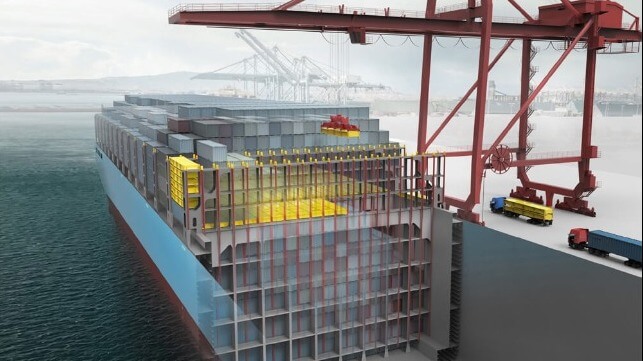Hyundai Develops “Lashing-Free” Loading for Containerships

South Korean shipbuilder Hyundai Heavy Industries has developed a new system for loading and securing containers that it says is both faster and safer with the potential to radically change container shipping. The shipyard reports it has received design approval from both the American Bureau of Shipping and the Liberian Flag administration for its new concept for lashing-free transport of containers.
The challenge of container safety and reducing the loss of boxes overboard gained increased industry attention in 2022 after several high-profile, large losses of containers. The World Shipping Council highlights that there are currently 6,300 ships moving cargo around the globe calculating that approximately 241 million containers are moved annually. Accidents such as the ONE Apus and Maersk Essen late in 2020 drove the average box loss to 3,113 in 2020-2021, far above the previous average which was at nearly 800 boxes annually.
While the losses overboard draw the most attention, Hyundai highlights the dangers and time spent loading and unloading boxes. No definitive data exists on how many dock workers or crewmembers are injured each year handling and lashing containers in ports around the world.
“The lashing-free containership is a new concept technology that can fundamentally eliminate lashing-related work, which is a major challenge in the containership industry, and cargo loss,” said Wonho Joo, head of Hyundai Heavy Industries’ technical division.
The lashing-free container ship design developed by Hyundai Heavy Industries uses a new concept device called a “portable bench” (trade name SkyBenchV2) that receives the load of the containers as they are stacked on deck and transfers it to the hull. The Cell Guide, a device that allows the vertical alignment and stacking of containers often 10 or more boxes high, has been extended above the deck. As the container is loaded on deck it is fixed by the expanded cell guide meaning there is no need for the lashing of individual boxes.
The traditional method of loading containers on deck uses a transverse-mounted lashing bridge. Containers are secured to the bridge with twistlocks. This lashing process serves as a support to prevent the containers from moving during operation.
According to Hyundai, the SkyBench structure traps the container on the deck in the cell guide. The system makes it possible to fix the container more stably than the existing lashing bridge structure, which they said will prevent accidents from collapsing or losing the container in rough seas, and also fundamentally preventing safety accidents that occur during lashing work.

that matters most
Get the latest maritime news delivered to your inbox daily.
“Lashing-free container technology is a groundbreaking technology that increases the safety and efficiency of container ship operation,” said Darren Leskoski, CEO of ABS Far East Asia.
Hyundai Heavy Industries has completed domestic and foreign patent applications for lashing-free containerships and portable benches.
